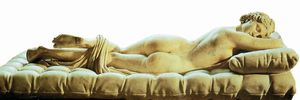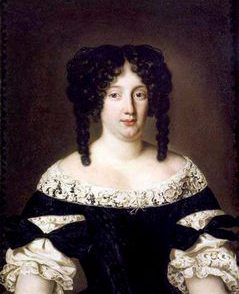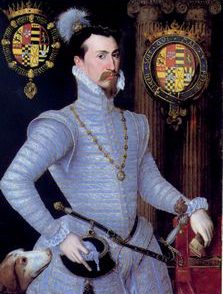One of the many arts cultivated in Renaissance Italy was the black art of
poisoning. The Medici Granducal Archives are teeming with references to this
nefarious branch of chemistry, including a series of documents confirming Grand
Duke Cosimo I de’ Medici’s involvement in a plot to assassinate Piero Strozzi
by means of poisoned food or drink in 1548. In February of that year, an
anonymous tipster writing in cipher to Cosimo pointed out that ‘P[iero]
St[rozzi] usually stops to drink a few times during his journey,’ and explained
that all that was needed was ‘an excellent toxin that could simply be put in
his drinking flask.’ A 1563 inventory of Cosimo’s personal archive implicates
him further in such sordid affairs: it shows that he kept a recipe for a deadly
poison among his important private papers.
Cosimo’s son
Ferdinando, suspected by some to have poisoned his older brother Francesco in
order to attain the Granducal throne in 1587, was every bit his father’s son,
even in this assassin’s art. Damning evidence of his darker side is in a letter
Ferdinando wrote to his agent in Milan in 1590: ‘A little poison is being sent
to you, made just for this purpose … the entire quantity is sufficient to
poison a whole flask of wine, and don’t use any less, and it is odorless,
tasteless, and has extremely powerful effects as long as you mix it well with
the wine…’ Ferdinando also promised his agent that up to four thousand scudi
would be rewarded to the person who succeeded in carrying out these instructions
for murder.
As these
notices suggest, poison was used to resolve political problems and heads of
state were its frequent victims. Ferrante Gonzaga di Guastalla was rumored to
be the target of the Farnese family’s poisoning plot in 1547. Cosimo de’ Medici
was warned in 1559 that anything he might eat or drink could have deadly
consequences. Felipe II, King of Spain, received the horrifying news in 1568
that his own son, Don Carlos, had attempted to poison him and his third wife,
Queen Elizabeth de Valois. The very same year, the King of France died and
widespread rumors posited poisoning. Queen Elizabeth I in 1586 narrowly escaped
a poisoning plot hatched by her lady-in-waiting. In 1603, the cook and head
waiter at the court of Henry IV of France plotted to taint the food of both the king and
his consort, Maria de’ Medici. When Queen Margarete von Habsburg, consort of
King Felipe III, died at the Escorial in 1611, the profuse bleeding from all orifices of
her head and her horridly deformed corpse cast suspicions of poisoning on her
pharmacist and doctor. Clearly, there were enough poisons circulating in the
courts of early modern Europe
to make every king and queen shiver with dread at the slightest aching stomach
or perception of an unusual taste.
The Medici
Archives record the scare experienced by the powerful minister of Spain, Gaspar de Guzmán, Duke of Olivares, when dining
in Valencia. ‘Having taken his first drink and tasting a very
unnatural flavor in the wine, he feared poisoning jumped away from the table in
a great fury asking for remedies…Meanwhile the wine steward, having heard what
was going on, reassured His Excellency that the bad taste resulted from his not
having rinsed the wine flask well after washing it with vinegar and salt, and
when the steward then preceded to drink the same wine, [Olivares] finally
calmed down.’ Amidst such rampant fear, we can understand why some rulers
reacted with vengeance upon discovering poisons in their midst, as in the case
of Alfonso d’Avalos, who had his servant drawn and quartered in 1542 for merely
having a poison in his possession.
While rulers were almost always in peril, it appears that no one was
beyond the reach of poison in early modern Europe-not the Jewish merchant from
Ferrara with a valuable diamond in his possession, who was poisoned by thieves
in 1558; nor the Franciscan friars of Borgo San Sepolcro, who were killed in
1565 with the poisoned breads left at their convent by a mysterious stranger;
nor the wives of two cuckholded husbands, Giangiacomo de’ Medici di Marignano,
and the Count of Bagno.
Wine and
food were the most preferred means of delivering poison to an enemy. The Medici
Archive demonstrates that other objects could also be laced with poison. Cosimo
I de’ Medici was warned in 1565 of a plot to poison his face towels; the
Lutheran community in Seville was accused in 1561 of poisoning the wells of
their Catholic neighbors; and Thomas Overbury, while imprisoned in the Tower of
London, succumbed to poisons hidden in his medicine in 1615.
In light of
all this poison-mongering, the question arises: what were the sources of the
poisons used in the Renaissance? At least some of the poisons could be found in
otherwise innocuous household items. For example, in 1568, a 14-year-old
Sienese girl who poisoned her family’s dinner salad in order to evade forced
entrance into a convent had obtained her deadly weapon by grinding down one of
the mercury glass mirrors that her mother and older sister used for primping.
Other poisons were the result of scientific research by botanical experts. A
‘liquor of venomous plants for killing large animals’ was prepared in Madrid at the request of Francesco de’ Medici in 1575
by the Duke of Alva’s herbalist. Along with the poison, the Duke of Alva also
sent Francesco special crossbow arrows that could deliver the poison under the
victim’s skin. The note that the Duke of Alva sent with the package of poison
explained that his herbalist ‘had never made such a good batch, which is why it
has taken so long to arrive.’ Ironically, the Duke of Alva also included in his
note a request for a refill of the Medici’s anti-poison oil, since his wife had
finished off their supply.
Though
usually poisoning was done for evil purposes, some deliberate poisonings did
not constitute legal murder, such as those that were designed to test the
efficacy of poison remedies. These dangerous experiments, which involved giving
the test subject a poison followed by the supposed antidote, were carried out
on animals like chickens and dogs, as well as humans awaiting capital punishment.
In 1546, the antidotal potency of a unicorn horn was tested successfully on a
dog. Two years later, Cosimo I de’ Medici sent Ferrante Gonzaga two vials from
an untested batch of the famous anti-poison oil produced in the Medici
pharmacy, recommending that Gonzaga
first test it out on a prisoner with a death sentence. Occasionally the test
subjects participated with full consent, as in 1660, when a renegade Roman
priest gained a following by performing ‘miraculous’ cures, which in truth were
caused by administering poisons and their cures-both brewed up by a local woman
known as Poisonous Girolama-to his collaborating servant in carefully
choreographed spectacles.







